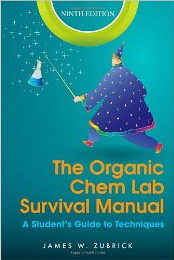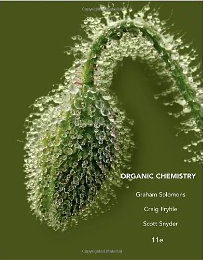A brief quiz covering recent lecture material will normally be given at the beginning of every other
class period. The first quiz will occur on the fourth day of class. Regular attendance is, thus,
necessary to achieve success in the course. The three lowest quiz scores will be discarded when
calculating the final quiz score. Make-up quizzes will not be administered under any
circumstances. All quizzes are closed-book, closed notes.
Laboratory notebooks will be prepared by the student and will be assessed by a
combination of self-evaluation and peer-evaluation (neither of which will affect
the actual grade in the course) and by evaluation by the lab instructor.
Students who perform all laboratory work, observe all chemical safety
regulations, and maintain an acceptable laboratory notebook will receive full
credit for laboratory effort (representing 67% of the lab grade). During the
final laboratory session, a laboratory examination will be administered. The
score on this examination represents 33% of the lab grade.
This is a complex project that can not be easily completed in one semester. During the first semester
of our course you will do the following:
The majority of the work for this project typically occurs in the second semester. In the first semester
you will do the following by the dates listed. All students in a team receive the same grade on each
milestone. It is important to share the work equitably. Milestones will only be accepted
electronically (unless previously arranged) by submission to greenchemistry@comcast.net with all
needed files attached. All milestones are due no later than 5pm on the due date. Submissions
received after the 5pm deadline will be penalized.
Scores on graded materials are not curved. Final grades will be computed as follows:
Make-up examinations will be allowed only if the absence is previously cleared
with the instructor or in the event of an emergency. In the case of illness, a
written note from the health care provider is required. In the case of a personal
emergency, a note from the Center for Student Development is required.
Laboratories during the first semester focus on development of techniques commonly used in the
organic chemistry laboratory. Through these experiences we will learn to perform organic chemical
reactions as well as some organic laboratory operations, such as use of ground glass chemical
apparatus, melting point determination, recrystallization, decolorization, vacuum filtration,
distillation (several types), extraction, drying, evaporation, gas chromatography and infrared
spectroscopy.
| Date | Reading
(before class) | Topic |
|---|
| Aug 28 | --- | Syllabus and Introduction
|
| Aug 30 | 1.1-7 | Carbon, bonds & charge
Homework (after class):
Textbook: 1.3, 1.11 |
| Sep 2 | --- | NO CLASS TODAY
Labor Day |
Sep 3
| 1, 2, Lab notebook handout
FW calculator
Collected Homework:
Organic Calculations
Due in two weeks | Lab Orientation, Checkin,
Honing Observational Skills by Candlelight
handout |
| Sep 4 | 1.9-11
1.16,17, 2.1-4
| Orbitals and hybridization
Molecular geometry; Representation of molecules
Homework (after class):
Textbook: 1.14, 1.15, 1.16, 1.50
Online problems; Solutions for online problems here |
| Sep 6 | 1.12-14, 2.5-9 | Structure vs. behavior: Introduction to functional groups
Homework (after class):
Textbook: 1.22, 1.35 |
| Sep 9 | --- | GOLum Beginnings
Green Chemistry lecture by Dr. John Warner video
Only available on Gordon College campus network |
| Sep 10 | handout | Laboratory Calculations - Due in class Friday
Refer to instructions from Friday's lecture |
| Sep 11 | ---
GOLum teams convene | Milestone #1 is completed |
| Sep 13 | 2.10-12
Top 100 Drugs | Carbonyl compounds
Homework (after class):
Take Two Assignment
Additional practice with functional groups:
2.8, 2.9, 2.12, 2.15, 2.17, 2.30acd, 2.33, 2.36, 2.53 |
| Sep 16 | 2.13,14 | Relationships Between Physical Properties
and Molecular Structure
Homework (after class):
Physical properties:
2.25, 2.27, 2.38, 2.46 |
| Sep 17 | 3,12, handout #1
handout #2,
Solomons 2.16 | Melting Point Determination and Significance
Infrared Spectroscopy |
| Sep 18 | 3.1-6,12-15 | GOLum brainstorming
Special Guest: Dr. Amy Cannon & Kate Anderson, Beyond Benign
Acids and bases in organic chemistry
Homework (after class):
Textbook: 3.1, 3.2, 3.9, 3.18, 3.20 |
| Sep 20 | --- | Acids and bases concluded
Homework (after class):
Textbook: 3.16, 3.17
Memorize Ka table as presented in class
Estimate the Ka of the drugs you explored in the Take Two homework |
| Sep 23 | 4.1-7 | Alkanes: Nomenclature and Properties
Homework (after class):
4.1 4.2, 4.5a |
Sep 24
| 4, 18, 19 (class 1),
handout | Simple Distillation
Boiling Point Determination
|
| Sep 25 | --- | GOLum Milestone #2 due
Nomenclature continued
Homework (after class):
4.6 4.7a, 4.8, 4.23 (skip parts l, m & n), 4.284.6 4.7a, 4.8, 4.23 (skip parts l, m & n), 4.28 |
| Sep 27 | --- | Special Guest: Dr. Gary Winn, DO
Nomenclature, concluded; Restrosynthetic concepts |
| Sep 30 | 4.15-17, 7.15 | Synthesis of alkanes
Homework (after class):
4.19, 4.33, and Outline the synthesis of 2,2-dimethyldecane using organic reactants
with six carbons or fewer as your starting materials. (click for solution) |
Oct 1
| 4, 18, 19 (class 3),
Distillation handout | Fractional Distillation
|
| Oct 2 | 4.8-10 | Conformational analysis of linear alkanes; Ring strain
Homework (after class):
4.13, 4.38 (these will require a little reading beyond our lecture today) |
| Oct 4 | 4.11-13 | Conformational analysis of cyclohexanes
Homework (after class):
Do the reading very carefully, then try these problems:
(note - for some of these, we have not yet covered this in class! But try it out)
4.15, 4.16, 4.17, 4.18, 4.36
Optional: molinspiration structure generator
To use molinspiration, draw structure and then click Galaxy 3D Generator button
WARNING! This software is in development; I have discovered errors. You might, too! |
| Oct 7 | 4.12-13 | Conformational analysis of cyclohexanes
Homework (after class):
Prepare for Op#1 |
Oct 8
| 30, 33 handout #1
handout #2,
Solomons 2.16 | Gas Chromatography of Distillate Fractions
Infrared spectroscopy of purified fractions |
| Oct 9 | --- | * * * OPPORTUNITY #1 * * * |
| Oct 11 | 5.1-6 | Stereochemistry: Chirality
Homework (after class):
5.1, 5.4, 5.5, 5.6 |
| Oct 14 | 5.7 | Stereochemistry: Nomenclature
Homework (after class):
5.9, 5.11, 5.12, 5.22, 5.36 |
Oct 15
| 6, 9, 11, 13, 17, 18,
handout | Synthesis and purification of an organic solid
|
| Oct 16 | 5.8-11 | ETHER DAY
Stereochemistry: Optical activity
Homework (after class):
5.15, 5.40abcdefgmnopq, 5.52 (best problem ever!) |
| Oct 18 | --- | No class, quad break |
| Oct 21 | 5.12-14,16 | NATIONAL CHEMISTRY WEEK!
Reaction types: Addition/Elimination/Substitution/Rearrangement
Homework (after class):
6.3, 6.24, addtional reaction types & curved arrow problems - click here for solutions |
| Oct 22 | --- | LAB: Greening the "Synthesis and purification of an organic solid" lab |
| Oct 23 | --- | The Most Chemical Day of the Year!
Mechanism: SN2 Nucleophilic Substitution
Homework (after class):
TBA |
| Oct 25 | 6.1-4, 14 | Mechanism: SN1 Nucleophilic Substitution
Homework (after class):
See 10/30 |
| Oct 28 | 6.5-8 | Competition: The SN2 vs. SN1 mechanism
Homework (after class):
see 10/30 |
| Oct 29 | --- | LAB: Microwave synthesis of an ionic liquid, [HMIM][Cl]
Adapted from: Solvent-free preparation of ionic liquids using a household microwave oven"
R. S. Varma and V. V. Namboodiri, Pure Appl. Chem., 2001, 73, 1309-1313.
Use of the CEM Discover Microwave Reactor |
| Oct 30 | 6.5-8 | Competition: SN2 vs. SN1 (continued)
Homework (after class):
6.7, 6.8, 6.9, 6.10, 6.19, 6.20, 6.23, 6.25, 6.27, 6.29 |
| Nov 1 | --- | No class today |
| Nov 4 | 6.13 | Competition between types: Substitution vs. Elimination
Homework (after class):
TBA |
| Nov 5 | --- | Day of Prayer |
| Nov 6 | 6.15-19 | Final thoughts from chapter 6; Introducing chapter 7
Homework (after class):
Prepare for Op#2 |
| Nov 8 | --- | * * * OPPORTUNITY #2 * * * |
| Nov 11 | 7.1-4 | Alkenes and alkynes: Nomenclature and stability
Homework (after class):
TBA |
| Nov 12 | 19 (class 3),
traditional
Revised version | Greener Dehydration of 2-Methylcyclohexanol
|
| Nov 13 | 7.5-8 | Alkene synthesis: Zaitsev's rule; Olefin metathesis
Homework (after class):
TBA |
| Nov 15 | 7.9-11 | Alkyne synthesis
Homework (after class):
TBA |
| Nov 18 | 7.12-14 | Hydrogenation revisited
Homework (after class):
TBA |
| Nov 19 | web resource | The Dose Makes the Poison: Comparative ecotoxicity
Optional: Browse the web resource:
The Science of Chemical Safety
Essential Toxicology |
| Nov 20 | 8.1-4 | Alkenes and alkynes: Ionic addition; Markovnikov's rule
Homework (after class):
TBA |
| Nov 22 | 8.5-10 | Oxymercuration/demercuration
Organoborane chemistry
Homework (after class):
TBA |
| Nov 25 | 8.11-13 | Alkene halogenation
Homework (after class):
TBA |
| Nov 26 | web resource | The Dose Makes the Poison: Comparative ecotoxicity
Collect results |
| Nov 27 | --- | No class, Prepare for Thanksgiving |
| Nov 29 | --- | No class, Recuperate from Thanksgiving |
| Dec 2 | 8.14-16 | Alkene reactions with carbene; Oxidation
Homework (after class):
TBA |
| Dec 3 | handout - See Professor | Green chemistry: Bromination of an alkene |
Dec 4 | 8.17-20 | GOLum Milestone #3 due
Alkyne reactions
Homework (after class):
TBA |
| Dec 6 | 11.1-6,10 | Alcohols: Reactions involving the O-H bon
Homework (after class):
TBAd |
| Dec 9 | 11.7-9,11,13 | Alcohols: Reactions involving the R-O bond
Ethers
Homework (after class):
TBA |
| Dec 10 | --- | Laboratory Exam; Check-out |
| Dec 11 | 11.12,14,15,17 | Ether reactions
Homework (after class):
Prepare for Op#3 |
| Dec 16 | Monday 9:00AM - 11:00AM | * * * OPPORTUNITY #3 * * * |

